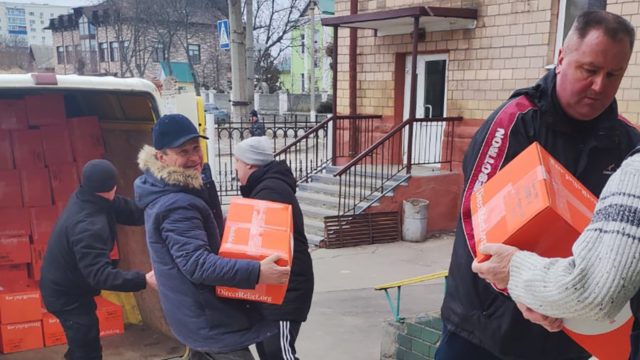
Ukrainian Public Organizations Help the Army Fight Russia
Publication: Eurasia Daily Monitor Volume: 19 Issue: 40
By:

Despite warnings by American and British intelligence services that Russia was planning a full-scale attack on Ukraine, most Ukrainian people did not believe that Russian President Vladimir Putin would undertake a full-scale invasion. They were convinced an attack would mean a strategic loss for Moscow, which is now evident to the entire world a month into the war (Pravda.com.ua, February 22). When the war began, many organizations found themselves unprepared to support the military operations that unfolded.
Civil society organizations in Ukraine have been assisting civilians in the occupied territories in Donbas since 2014. But their efforts were limited to legal and logistical consultations because crossings through the demarcation line did not work for a long time, as they were blocked by the Russia-controlled occupation administrations. Other organizations were supporting veteran communities. Non-profits specifically involved in helping the army had mainly adapted to the configuration of the war after the hot years of 2014–2015.
But they changed their strategy and tactics very quickly as soon as Russia attacked Ukraine on February 24, becoming effective suppliers of essential gear to Ukraine’s army and territorial defense. The overwhelming support of Ukrainians for their army helped reorganize the activities of such organizations rapidly and effectively. The Ukrainian people massively donated funds to the military, collecting astonishing amounts through organizations such as “Come Back Alive” Foundation for assisting the army (Disclosure: the author is an analyst for “Come Back Alive”), through an account opened at the National Bank of Ukraine in support of the Armed Forces of Ukraine, and many charitable initiatives to help the army (Radio Svoboda, March 12; Interfax, March 11). On the first day of the bank account opening, the Ukrainians sent almost 300 million hryvnias (over $10 million) (Bank.gov.ua, February 25). By mid-March, the “Come Back Alive” Foundation was able to transfer high-tech equipment and personal protective gear to Ukraine’s defenders for more than a billion hryvnias (over $33 million) (Facebook.com/backandalive, March 14).
This support is essential not only from a material point of view: it is also a catalyst for national mobilization. It enables communication between the civilian population and the army, conveying support for its fight. This support proves that the war is truly the people’s war for Ukrainians. It also shows that Russia may strike Ukrainian cities and villages but will be unable to hold them because, contrary to Russian propaganda, the civilian population will only assist the Ukrainian forces and not the Russian occupiers.
However, civil society organizations still face difficulties because Ukrainian authorities could not arrange for urgent deliveries of necessary dual-use goods from abroad, at least not as fast as the situation required. Passing customs control takes time and bureaucracy still significantly slows down the processing of supplies (Hromadske.ua, March 14). The challenges for those who plan logistics to obtain and redistribute dual-use goods remain unprecedented: in addition to transport to get them across the border, it is necessary to deliver these goods to points across the country to their direct recipients—Ukrainian military personnel.
A big challenge for the army assistance organizations was prioritizing their tasks and determining each specific organization’s area of responsibility to be more effective. Thus, in the first days of the war, an important task was to learn how to decline part of the requests that would not correspond with the organization’s mission—because, in a war, everything seems urgent. The division of responsibilities between different organizations and effective redirection of donors between them is one of the most significant components of the work to help the army today. And this work is primarily about awareness, effective communication, and redirecting donors to the groups that can provide the requested assistance. For example, at “Come Back Alive,” this is done through hotlines where the donor is directly brought to the organization that deals with the required assistance. The people volunteering for those organizations are indispensable in ensuring the aid reaches the army units that need it.
Protection from the sky remains the most urgent task: Ukrainian fighters need unmanned aerial vehicles (UAV) and other equipment that allow the air-defense forces to see the enemy in advance and quickly become aware of their plans. The means of communication are also of great importance. They should be a priority when deciding how to allocate funds, what supplies to focus on, and which units to help first. The emphasis on aerial defense remains the main one. And this is precisely what Ukraine is discussing with its Western partners, both in the context of establishing no-fly zones and in the context of additional arms supplies (24tv.ua, March 16). Without this, humanitarian assistance for the civilian population and protective equipment supplies for the military will not reach the intended recipients. After all, the humanitarian situation of the civilian population can be effectively alleviated only if security is achieved and protected zones created, at least temporarily. Personal protective equipment will not save many people if the strikes come from above.
The people involved in helping the Ukrainian army are at significant risk since Russia declared “demilitarization” as one goal of its aggression against Ukraine—thus, Moscow threatens both the Ukrainian army and those who help it. However, the military is the only force capable of stopping Russia’s war against Ukraine, which means that this assistance will continue for as long as necessary.



